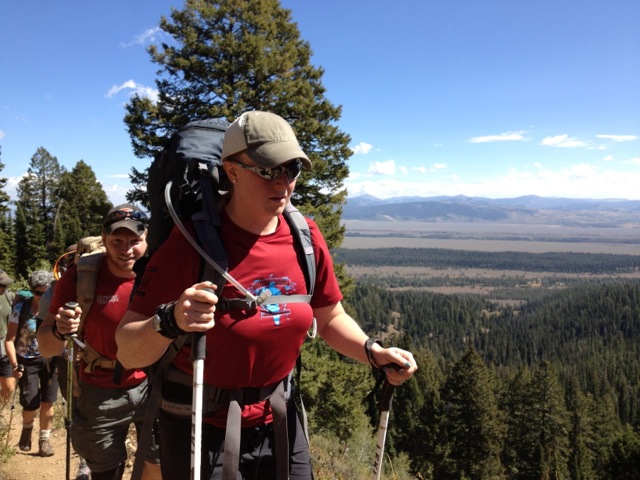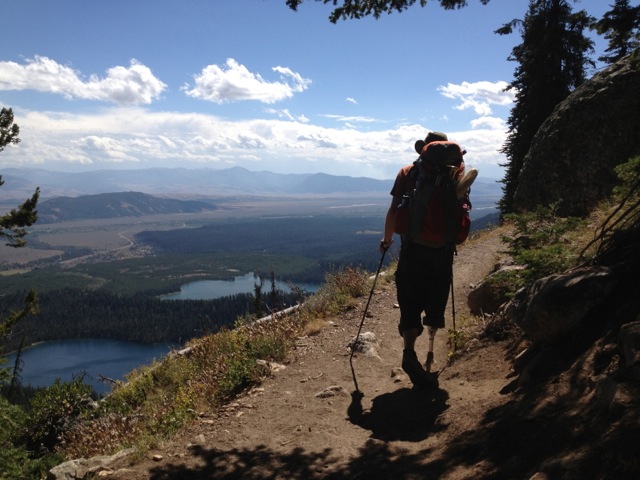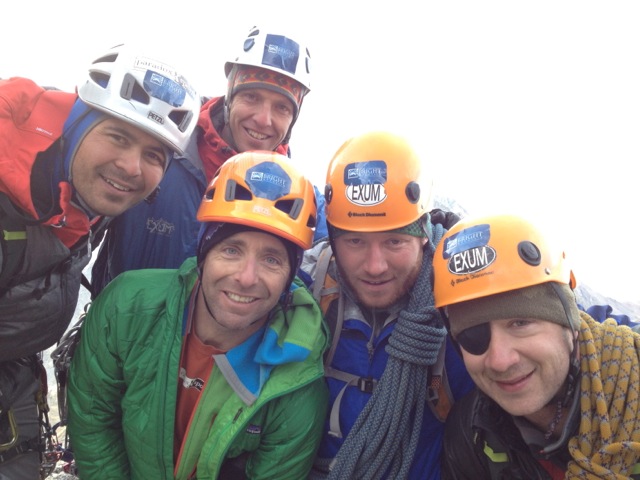The Brightest Spot on the Mountain: Injured Veterans Climb Grand Teton to Honor Those Who Died on 9/11
“These days I disassociate with that girl in the wheel chair. Yes I still have challenges, but I’m not disabled. I’m living, and to prove that I climbed a mountain on September 11. It was the best way I knew how to counteract the horrific events of that day in 2001. Now I have a reason to celebrate this day.”
“People who know my story still look at me as if I’m broken, but that’s not who I am. I want to be seen as a whole person and not focus on the day of my injuries, because they no longer define me,” explained Nicollete Maroulis, 35, from Austin, Texas. Maroulis is one of three physically challenged veterans who climbed Grand Teton on September 11, 2012 to honor all those who lost their lives on Sept. 11, and all those who have stepped forward to protect our country.

Guide Michael Abbey leads the group up the mountain followed by Nicolette Maroulis
The idea for the 9/11 climb was a collaboration between Paradox Sports, a non-profit in Golden, Colorado that arranges guided outdoor adventures for those with physical challenges, and Boca Raton-based My Bright Mountain, a large, growing news website with an even grander mission to give profits back to charities like Paradox Sports.

The team as it heads up to the summit with clear skies

Nicolette Maroulis and Andrew Sullens leading the pack as the team sets off for the summit
Compelled to do her part to protect America, Nicollete joined the US Navy on September 12, 2001, the day after the World Trade Center attacks. She worked as a highly respected K9 Handler of a bomb-sniffing dog, but an explosion in 2003 left her with knee, back, and traumatic brain injuries requiring multiple surgeries, five in the past year alone.
During her three and a half years in a wheelchair, doctors feared Nicollete would never walk again. “At first I was bitter about my situation and saw myself as this battered girl with a long list of limitations. I was comfortable being uncomfortable and wanted to be alone.” But with an extreme attitude adjustment and extraordinary will, Nicollete built strength by lifting weights and began walking, rowing, cycling, and then remarkably, climbing mountains. She found sports to be the major healer in her life. “These days I disassociate with that girl in the wheel chair. Yes I still have challenges, but I’m not disabled. I’m living, and to prove that I climbed a mountain on September 11. It was the best way I knew how to counteract the horrific events of that day in 2001. Now I have a reason to celebrate this day.”

Nicolette Maroulis rappels down from the summit
Before Grand Teton, Nicollete scaled the ultra challenging Mount Lobuche in the Himalayas with fellow veteran Chad Jukes (28) from Ridgeway, Colorado, who also climbed Teton on September 11. While in the US Army in Northern Iraq in 2006, Jukes found himself hanging upside down from a tree with catastrophic injuries to his leg after an IED bomb exploded under the truck where he was riding as a passenger. After multiple surgeries and a serious staph infection, doctors told Chad that he had an important decision to make. “I had to choose between keeping my leg and not being able to use it, or I could have it amputated from the knee down. With a prosthetic device, I was told I’d be able to walk and move quite normally,” explained Chad. “I couldn’t imagine being crippled, so I chose amputation.”

Chad Jukes
Hiking up the technically challenging slopes of Teton with all their gear in tow and adjusting to the elevation brought about joint pain, headaches, dizziness, and nausea among the veterans. Climbing seven miles down in one day was even more brutal. “Each step was jarring and physically taxing on my prosthetic, so I had significant pain as we descended,” said Chad, who opts not to take prescription pain medication. Fellow climber Andrew Sullens (29) had a battery-operated pump to maintain the vacuum seal on his prosthetic leg. Unfortunately it stopped working on the way up the mountain, resulting in a great deal of swelling, causing the artificial limb to no longer fit properly. With debilitating pain, he had to stay back and rest an extra night with a couple of guides to let the swelling go down.

Chad Jukes on the trail with expansive views in the distance
Like Chad Jukes, Andrew Sullens was riding in a vehicle when he sustained many significant injuries while enlisted. He was stationed in Afghanistan as a National Guardsman in 2009 when an IED bomb detonated, shattering his hip and causing him to lose part of his right leg. With his prosthetic device, he’s not only climbing mountains, biking, and kayaking, but he was also a member of the Sheriff’s SWAT team in Lumpkin County, Georgia. Andrew’s leg device malfunction on Grand Teton may have caused him a slight setback on this expedition, but letting it defeat him was not an option; the next day he made it down safely.

Climbing Grand Teton requires a great deal of technical skill
As it turned out, Mother Nature provided plenty of opposition for all the climbers. Chad explained, “It got very cold, and the wind was so loud we had to yell into another climber’s ear just to communicate. It’s very isolating when gusts are pushing you around and wind is the only sound you can hear. It messes with your mind and ups the psychological ante of the climb.”
The climbers were all exhausted from conquering five unique, technically challenging pitches, but at night in the tent at 11,600 feet, the wind was so relentless that sleep was virtually impossible. Chad found it calming to see elk, deer, big horn sheep, marmots, and pika scattered on the mountain, but not so when a mouse unexpectedly crawled up on his foot in the tent. The team was up and ready to go at 4:40 am.

Windy base camp at the Lower Saddle at about 11,650 feet
Timmy O’Neil, Executive Director of Paradox Sports, led the group to the summit with several fellow guides, two of whom are also war veterans. “People often come up with reasons why they can’t overcome barriers,” said O’Neil, “But life is impermanent, and you’ve got to live every minute of it no matter what you believe your limitations to be. When you’ve seen I can’t turn into I must and then I did, like I have, it completely changes the way you think about your own life’s challenges.” O’Neil has witnessed many others with so-called disabilities achieve the unthinkable, including his own brother, a paraplegic, who climbed 3,000 feet up El Capitan in Yosemite National Park solely with the use of his upper body strength.

From left to right: Michael Kirby, Michael Abbey, Timmy O’Neill, Andrew Sullens and Eric Gray
My Bright Mountain, the news and information website which sponsored the climb, was founded by Kip Speyer, who lost his 22-year-old brother and only sibling years ago in Vietnam. “My mother cried every day for over a year after he died, and I vowed to one day do something to honor him and help other war veterans,” recalled Speyer.
As the My Bright Mountain website grows, Speyer is more focused than ever on his goal to raise millions of dollars to pass on to a variety of charities, including those that help US veterans like Paradox Sports. “Veterans like Andrew, Nicollete, and Chad demonstrate to us the secret of success - eliminate mental boundaries, challenge your physical limitations, and stay on the good side of things so that good things will happen,” said Speyer.

Andrew Sullens helping on the ropes
What these three veterans have in common is a refusal to be limited by their injuries or to wallow in self-pity. “It comes down to this,” said Nicollete. “You can’t let other people set limits for you. Stop listening to naysayers, get off that couch and start working toward your goals. You know what you’re capable of doing, and you’re responsible for the risks you’re taking.”

The team heads down after reaching the summit past spots of ice and snow
Another quality these vets share is the unfaltering desire to help others. Chad Jukes said, “People see me climb mountains with half my leg missing, so they realize they too can challenge themselves to accomplish great things, despite their own life-altering injuries. It’s rewarding to be involved with outdoor adventures that help others like me discover how nature can be so magically healing.” Nicollete, who is back in school to earn a degree in Sports and Health Science, donates much of her time volunteering to help veterans like her who need to know there is life after war and that someone cares about their well being.
When the group reached the summit on September 11 early in the morning, the air was a crisp 32 degrees, the sky was a vivid blue, and the sun shone brightly. There was a moment of somber silence as Chad Jukes played “Taps” on the trumpet to honor those who died on 9/11, eleven years ago, followed by celebration for conquering the mountain. Chad noted, “It was rewarding to reach the top, and perhaps even more triumphant when we safely took our last step off that mountain. Honestly all I could think about was eating pizza and sipping a victory beer.” With laughter, he added, “But by the time we got to the restaurant, I was practically slumped over the food from exhaustion and could barely eat.”

From left to right: Eric Gray, Andrew Sullens, Timmy O’Neill and Michael Kirby
In the weeks that follow the climb, the team continues to get recognition and praise. “Climbing allows you to elect to suffer and prepares you for times when you have setbacks, which we all do. These veterans proved on this mountain that they are not limited by their injuries, and America will not be bound by the events of September 11, 2001,” Timmy O’Neil said.
Kip Speyer summed it all up, “You may call the injured veterans of the Grand Teton climb determined, triumphant, and heroic, but don’t call them disabled. They won’t even know what you’re talking about.”
Feature photo: The MyBrightMountain.com Paradox Sports 9-11 Veterans Climb team celebrates reaching the summit on Sept. 11.
All photos courtesy and copyright My Bright Mountain
